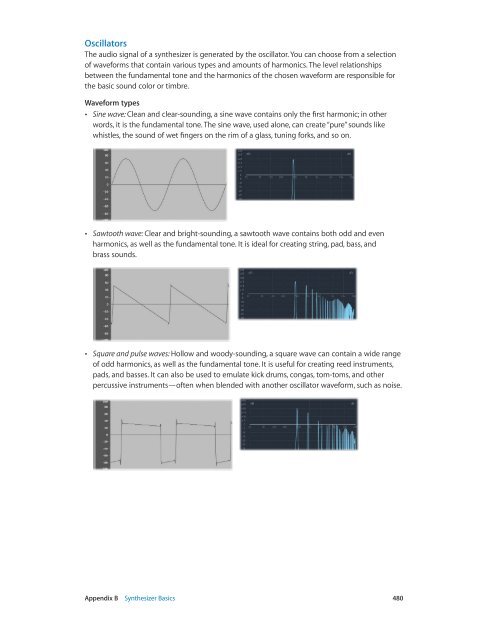Apple MainStage 3 Instruments - MainStage 3 Instruments
Apple MainStage 3 Instruments - MainStage 3 Instruments
Apple MainStage 3 Instruments - MainStage 3 Instruments
Create successful ePaper yourself
Turn your PDF publications into a flip-book with our unique Google optimized e-Paper software.
Oscillators<br />
The audio signal of a synthesizer is generated by the oscillator. You can choose from a selection<br />
of waveforms that contain various types and amounts of harmonics. The level relationships<br />
between the fundamental tone and the harmonics of the chosen waveform are responsible for<br />
the basic sound color or timbre.<br />
Waveform types<br />
••<br />
Sine wave: Clean and clear-sounding, a sine wave contains only the first harmonic; in other<br />
words, it is the fundamental tone. The sine wave, used alone, can create “pure” sounds like<br />
whistles, the sound of wet fingers on the rim of a glass, tuning forks, and so on.<br />
••<br />
Sawtooth wave: Clear and bright-sounding, a sawtooth wave contains both odd and even<br />
harmonics, as well as the fundamental tone. It is ideal for creating string, pad, bass, and<br />
brass sounds.<br />
• • Square and pulse waves: Hollow and woody-sounding, a square wave can contain a wide range<br />
of odd harmonics, as well as the fundamental tone. It is useful for creating reed instruments,<br />
pads, and basses. It can also be used to emulate kick drums, congas, tom-toms, and other<br />
percussive instruments—often when blended with another oscillator waveform, such as noise.<br />
Appendix B Synthesizer Basics 480
















